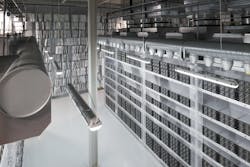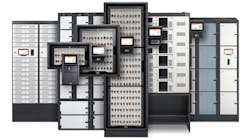As more customers seek data center space without backup generators or UPS support, service providers are developing products to meet this demand.
The “variable resiliency” use case may seem like an outlier at the moment, representing a small percentage of customers. But companies specializing in this niche predict that demand will grow as end users become more educated about third-party data center offerings.
An example can be found in Kevlavik, a rocky peninsula in the south of Iceland where a steady wind delivers cool air to data centers operated by Verne Global, where that air is filtered and used to cool IT equipment for companies from around the globe. The winds of change are reshaping the way customers use that power, which is changing how Verne builds its data centers.
Verne Global sees growing demand for its new PowerDIRECT offering, which provides data center space supported only by grid power. It continues to offer a traditional Tier III offering called Power ADVANCE.
“Companies can be very forward-thinking in their infrastructure,” said Tate Cantrell, Chief Technology Officer of Verne Global. “People really aren’t that concerned about the data center itself. They’re concerned with the products above the platform. We’re definitely seeing a pickup in demand for PowerDIRECT.”
Variable Resiliency Gains Traction
It’s not alone, either, as several other leading providers are also offering variable resiliency space. This week Sentinel Data Centers said it now has more than 5 megawatts of customer capacity using its Transmission+ product, an “infrastructure light” solution supported by grid power. Sentinel is offering the product in its New Jersey and North Carolina data centers.
“Our leasing success with Transmission+ is a clear indicator of the growing demand among large data center users for more versatile data center solutions,” said Josh Rabina, Co-Chief Executive Officer of Sentinel Data Centers. “The ability to vary resiliency and cost on a workload by workload basis is clearly resonating with smart buyers of large-scale colocation services.”
The 100 kV substation supporting the Sentinel Data Centers’ project in Durham, N.C. The robust utility infrastructure allows Sentinel to offer variable resiliency plans to customers. (Photo: Sentinel Data Centers).
There are other examples as well. In Silicon Valley, Vantage Data Centers has leased more than 5 megawatts of space supported by grid power, which is being used for research labs. DuPont Fabros Technology said it is designing the next generation of its data centers to offer broader ranges of power density and resiliency.
“As the industry has grown, customers have become more savvy,” said Sureel Choksi, the CEO of Vantage. “They come in knowing what they want, and are clear about what they want to pay. We’ve got a variety of things we can do. We offer all of those options, and work with our customers to configure what they need.”
Matching Costs and Workloads
This is a trend that bears watching. To be sure, the vast majority of data center users still want traditional Tier III space with exceptional uptime.
But the variable resiliency trend is showing signs of being more than a novelty or niche play, and emerging as a strategic option for companies with complex infrastructure. With the emergence of hybrid cloud computing, enterprise customers are now combining platforms and technologies, with applications running on premises, in colocation centers, and in public clouds.[clickToTweet tweet=”Sentinel’s Josh Rabina: The ability to vary resiliency and cost by workload is clearly resonating.” quote=”Sentinel’s Josh Rabina: The ability to vary resiliency and cost by workload is clearly resonating.”]
As customers pay closer attention to the needs of individual workloads, they may see a payoff in shifting non-critical applications to low-resiliency facilities. Verne Global’s PowerDIRECT is less than half the cost of its Tier III PowerADVANCE offering.
“It’s one of those things where money talks,” said Cantrell. “The conversation has been easier than I expected.”
A Path Paved by Bitcoin Miners
That conversation began in 2014, when several bitcoin mining companies set up shop at Verne Global, attracted by Ice;and’s abundant supply of affordable power. The arms race in Bitcoin hardware makes mining a low-margin game, with the key criteria being the cost of power and the ability to cool high-density hardware.
“It made us completely rethink the way we design data centers,” said Cantrell. “We were put up to the challenge of ‘here’s a price point, can you meet it?’ With this product, we got down to ‘what is the minimum requirement for our facility?'”
Cool air enters the Verne Global data center through these louvers in the exterior of the building. (Photo: Rich Miller)
Verne Global created space supported by grid power, with no generator or UPS (uninterruptible power supply), cooled with fresh air introduced through louvers and then filtered before reaching the IT equipment. “We’ve tuned this design to the local climate here in Iceland,” said Cantrell. “We were able to be resoundingly successful in a commoditized infrastructure business like the blockchain.”
Most of Verne Global’s customers – including enterprise clients and service providers – continued to operate in traditional Tier III space. But some became curious about the reliability of the lower resiliency space, which still benefits from the campus’ dedicated substations and two connections to the Icelandic grid.
“We have a customer who has had enterprise-class equipment in this environment for more than a year now,” said Cantrell. “They’re now migrating their entire infrastructure from our Tier III infrastructure into PowerDIRECT.”
That tenant is shifting all its processing workloads into the PowerDIRECT product, while maintaining its network infrastructure and financial applications in the Tier III Power ADVANCE space. Verne Global believes this type of hybrid configuration will be attractive to many enterprise tenants with diverse workloads, and is building out its campus to optimize for it.
Designing for Flexibility
The company’s 44 acre campus on a former NATO Air Base features two data centers. The initial building is optimized for modular data centers, but the newest data center is designed to support both the company’s offerings. Much of the 120,000 square foot building will be PowerDIRECT space supported by grid power.
“We’ve also optimized the design to offer 1 megawatt suites of Power ADVANCE at N+1 or 2N,” said Cantrell. “We’ve designed some of this space as Meet me rooms, which gives us flexibility.”
A key selling point for Verne Global is Iceland’s supply of hydro power, generated by dams like this one at the Ljósafossstöð hydroelectric plant on the River Sog. (Photo: Rich Miller)
The design allows tenants to run low-resiliency workloads in one area, and mission-critical gear in an adjacent room. It’s an approach that allows tenants to match their costs to their workloads in a more efficient manner.
This is already happening in the data center industry. An example is Digital Realty’s connected campus concept, which allows tenants to split infrastructure between network-rich interconnection facilities (where space typically fetches a premium) and larger footprints in wholesale data centers. The same hybrid concept concept could eventually extend to space with variable levels of redundancy.
About the Author



